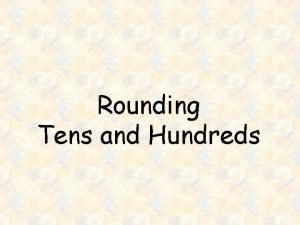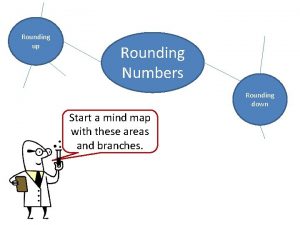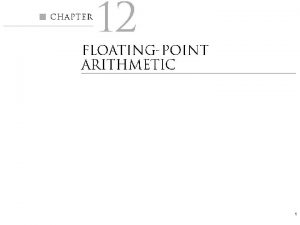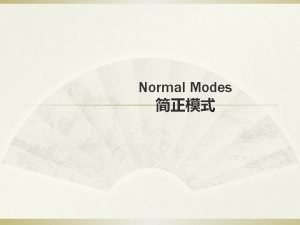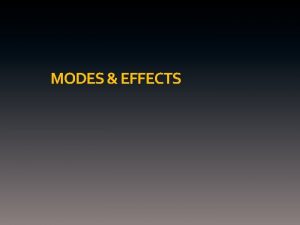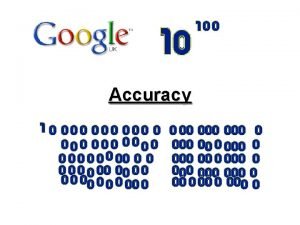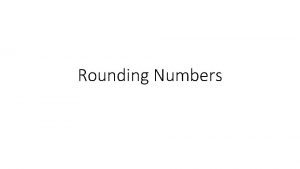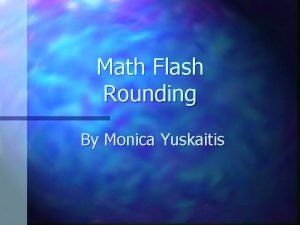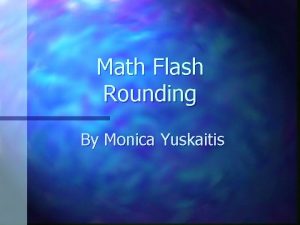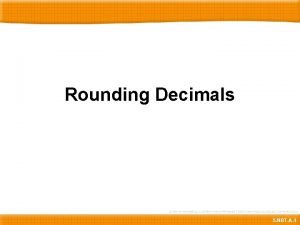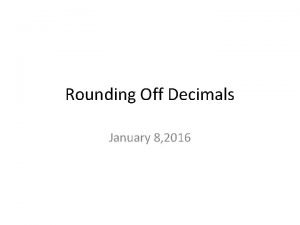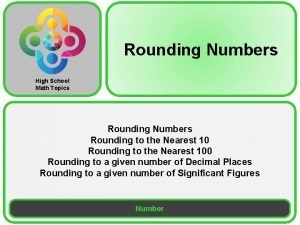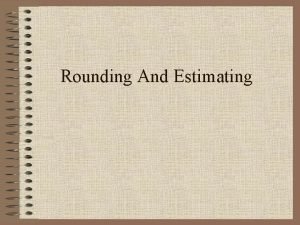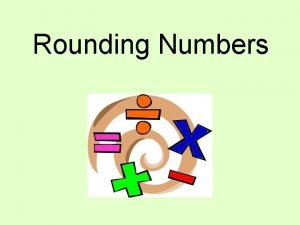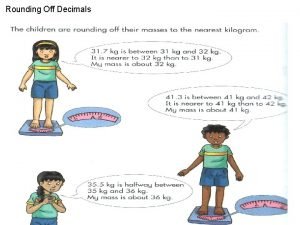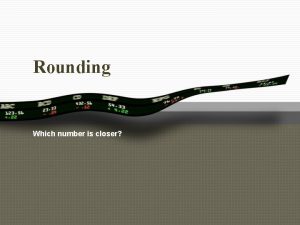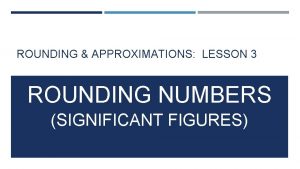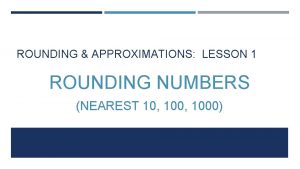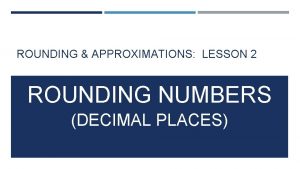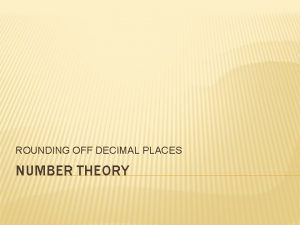1 12 1 Rounding Modes 2 Rounding the







![Figure 12. 3 Two directed round-to-nearest-integer functions for x in [– 4, 4]. 8 Figure 12. 3 Two directed round-to-nearest-integer functions for x in [– 4, 4]. 8](https://slidetodoc.com/presentation_image/3d8b5a87c9b36ab8889c950c0f5e2623/image-8.jpg)

















- Slides: 25

1

12. 1 Rounding Modes 2

Rounding: the process to obtain the best possible floating-point representation for a given real value. ANSI/IEEE standard: round to floating number whose significand has an LSB of 0 (of two adjacent floatingpoint number, the significand of one must end in 0, and the other one in 1). This is called round-to-neareven. For example, 3. 5 and 4. 5 are both rounded to 4, the closet even number, based on round-to-near-even. 3

• Other rounding methods – Round inward (toward 0): choose the nearest value in the same direction as 0. – Round upward (toward +∞): choose the larger of the two possible values. – Round downward (toward -∞): choose the smaller of the two possible vavlues. • 4

Example 12. 1 Rounding to the nearest integer a. Consider the rounded even integer corresponding to a real signed-magnitude number x a rtnei(x). Plot this round-tonearest-even-integer for x in the range [-4, 4]. b. Repeat part a for the function rtni(x), that is, round-to-nearest-integer function, where the midway values are always rounded up 5

6

Example 12. 2 Directed rounding a. Consider the inward-directed round corresponding to a real signed-magnitude number x as a function ritni(x). Plot this round-inward-to-nearest-integer function for x in the range [-4, 4]. b. Repeat part a for the round-upward-to-nearest -integer rutni(x). 7
![Figure 12 3 Two directed roundtonearestinteger functions for x in 4 4 8 Figure 12. 3 Two directed round-to-nearest-integer functions for x in [– 4, 4]. 8](https://slidetodoc.com/presentation_image/3d8b5a87c9b36ab8889c950c0f5e2623/image-8.jpg)
Figure 12. 3 Two directed round-to-nearest-integer functions for x in [– 4, 4]. 8

Figure 12. 3 (Continued) 9

12. 2 Special Values and Execeptions • Five special values in ANSI/IEEE floating-point standard – ± 0 Biased exponent=0, significand=0 (no hidden 1) –±∞ Biased exponent=255 (short), or 2047 (long), significand=0 – Na. N Biased exponent=255 (short), or 2047 (long), significand≠ 0 10

12. 3 Floating-Point Addition Consider the addition of ± 2 e 1 s 1 and ± 2 e 2 s 2, where e 1 > e 2 (± 2 e 1 s 1) +(± 2 e 2 s 2)=± 2 e 1(s 1±s 2/2 e 1 -e 2) 11

12

Figure 12. 6 Simplified schematic of a floating-point adder 13

12. 4 Other Floating-point Operations Multiplication of ± 2 e 1 s 1 and ± 2 e 2 s 2 (± 2 e 1 s 1)×(± 2 e 2 s 2)=± 2 e 1+e 2(s 1×s 2/2 e 1 -e 2) Division of ± 2 e 1 s 1 and ± 2 e 2 s 2 (± 2 e 1 s 1)/(± 2 e 2 s 2)=± 2 e 1 -e 2(s 1/s 2) 14

Figure 12. 6 Simplified schematic of a floating-point multiply/divide unit. 15

12. 5 Floating-Point Instructions 10 floating-point arithmetic instructions (5 different operations: add, sub, multiply, divide, negate) add. s $f 0, $f 8, $f 10 # set $f 0 to ($f 8)+($f 10) add. d $f 0, $f 8, $f 10 # set $f 0 $f 1 to ($f 8$f 9)+($f 10$f 11) Single operands can be in any of the floating registers. Double operands must be in specified to be in even numbered registers Figure 12. 7 The common floating-point instruction format for Mini. MIPS and components for arithmetic instructions. The extension (ex) field distinguishes single (* = s) from double (* = d) operands. 16

6 format conversion instructions: integer to single/double, single to double, double to single, and single/double to integer cvt. s. w $f 0, $f 8 cvt. d. s $f 0, $f 8 cvt. s. d $f 0, $f 8 cvt. w. s $f 0, $f 8 cvt. w. d $f 0, $f 8 # set $f 0 to single (integer $f 8) # set $f 0 to double ($f 8) # set $f 0 to single ( $f 8, $f 9, ) # set $f 0 to integer ($f 8, $f 9) Figure 12. 8 Floating-point instructions format conversion in Mini. MIPS. 17

6 data transfer instructions: load/store word to/from coprocessor 1, move single/double from one FP register to another, move (copy) between FP registers and CPU general registers. lwcl $f 8, 40($3) # load mem[40+($s 3)] into $f 8 swc 1 $f 8, A($3) # store mem[A+($s 3)] into $f 8 mv. s $f 0, $f 8 # load $f 0 with ($f 8) mv. d $f 0, $f 8 # load $f 0, $f 1 with ( $f 8, $f 9, ) mfc 1 $t 0, $f 12 # load $t 0 with ($f 12) mtc 1 $f 8, $t 4 # load $f 8 with ($t 4) Figure 12. 9 Instructions for floating-point data movement in Mini. MIPS. 18

2 branch and 6 comparison instructions. The FP unit has a flag that is set to T or F based on 6 comparisons (equal, less than, or less or equal for single/double data type) bc 1 t L # branch on FP flag true bc 1 f L # branch on FP flag false c. eq. * $f 0, $f 8 # if ($f 0)=($f 8), set flag to true c. lt. * $f 0, $f 8 # if ($f 0)<($f 8), set flag to true c. lw. * $f 0, $f 8 # if ($f 0)≤($f 8), set flag to true Figure 12. 10 Floating-point branch and comparison instructions in Mini. MIPS. 19

Table 12. 1 The 30 Mini. MIPS floating-point instructions: because the op field contains 17 for all but two of the instructions (49 for lwc 1 and 50 for swc 1), it is not shown. 20

12. 6 Result Precision and Errors • FP arithmetic can be quite dangerous and must be used with proper care, because results of FP computations are inexact. • Why? – Many real numbers do not have exact binary representation within a finite word format. This is referred as representation error. – Even for values that are exactly representable, FP arithmetic produces inexact results. For example, product of 2 short FP numbers will have a 48 bits significant that must be rounded to 23 bits (plus hidden 1) This is called computation error. 21

Example 12. 4 Associate law of addition does not hold in general in FP arithmetic. For example a= -25×(1. 10101011) b=25 × (1. 10101110) c=-2 -2 × (1. 01100101) (a+b)+c = a+(b+c) ? 22

Figure 12. 11 Algebraically equivalent computations may yield different results with floating-point arithmetic. 23

• Using guard digits to avoid excessive error. For example, in a 10 -digit calculator, 1/3 is represented as 0. 333 333 3, multiplying 3 results in 0. 999 999 9, but not 1. However, in a calculator with 2 guard bits, 1/3 is represented as 0. 333 333, but still displayed as 0. 333 333 3, multiplying 3 results in 1. 24

Figure 12. 12 Function evaluation by table lookup and linear interpolation. 25
 V cc cc
V cc cc Làm thế nào để 102-1=99
Làm thế nào để 102-1=99 Thể thơ truyền thống
Thể thơ truyền thống Alleluia hat len nguoi oi
Alleluia hat len nguoi oi Sự nuôi và dạy con của hươu
Sự nuôi và dạy con của hươu đại từ thay thế
đại từ thay thế Diễn thế sinh thái là
Diễn thế sinh thái là Vẽ hình chiếu vuông góc của vật thể sau
Vẽ hình chiếu vuông góc của vật thể sau Công thức tính độ biến thiên đông lượng
Công thức tính độ biến thiên đông lượng Thế nào là mạng điện lắp đặt kiểu nổi
Thế nào là mạng điện lắp đặt kiểu nổi Tỉ lệ cơ thể trẻ em
Tỉ lệ cơ thể trẻ em Lời thề hippocrates
Lời thề hippocrates Vẽ hình chiếu đứng bằng cạnh của vật thể
Vẽ hình chiếu đứng bằng cạnh của vật thể Phản ứng thế ankan
Phản ứng thế ankan Quá trình desamine hóa có thể tạo ra
Quá trình desamine hóa có thể tạo ra Các môn thể thao bắt đầu bằng tiếng chạy
Các môn thể thao bắt đầu bằng tiếng chạy Hát kết hợp bộ gõ cơ thể
Hát kết hợp bộ gõ cơ thể Khi nào hổ mẹ dạy hổ con săn mồi
Khi nào hổ mẹ dạy hổ con săn mồi điện thế nghỉ
điện thế nghỉ Các loại đột biến cấu trúc nhiễm sắc thể
Các loại đột biến cấu trúc nhiễm sắc thể Nguyên nhân của sự mỏi cơ sinh 8
Nguyên nhân của sự mỏi cơ sinh 8 Trời xanh đây là của chúng ta thể thơ
Trời xanh đây là của chúng ta thể thơ Chó sói
Chó sói Thiếu nhi thế giới liên hoan
Thiếu nhi thế giới liên hoan Phối cảnh
Phối cảnh Một số thể thơ truyền thống
Một số thể thơ truyền thống


























